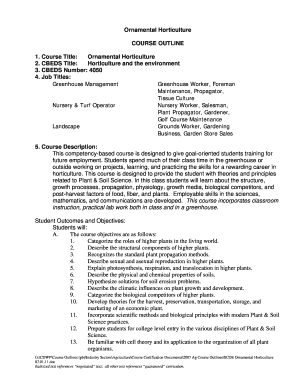Fill and Sign the Curriculum Outline Template Form

Convenient tips on preparing your ‘Curriculum Outline Template’ online
Are you fed up with the inconvenience of handling paperwork? Look no further than airSlate SignNow, the premier electronic signature platform for individuals and organizations. Bid farewell to the monotonous task of printing and scanning documents. With airSlate SignNow, you can easily complete and sign paperwork online. Utilize the robust features packed into this user-friendly and cost-effective platform and transform your document management approach. Whether you need to authorize forms or collect signatures, airSlate SignNow manages it all seamlessly, demanding just a few clicks.
Follow these step-by-step instructions:
- Log into your account or register for a free trial with our service.
- Click +Create to upload a file from your device, cloud, or our form collection.
- Open your ‘Curriculum Outline Template’ in the editor.
- Click Me (Fill Out Now) to finalize the form on your end.
- Add and assign fillable fields for others (if necessary).
- Proceed with the Send Invite settings to solicit eSignatures from others.
- Download, print your copy, or convert it into a reusable template.
No need to worry if you wish to collaborate with your teammates on your Curriculum Outline Template or send it for notarization—our solution has you covered with everything you need to complete such tasks. Register with airSlate SignNow today and take your document management to the next level!
FAQs
-
What is a Curriculum Outline Template?
A Curriculum Outline Template is a structured format that helps educators design and outline their course content effectively. With airSlate SignNow, you can create and customize a Curriculum Outline Template that suits your educational needs, ensuring a clear presentation of your teaching objectives and materials.
-
How can I customize my Curriculum Outline Template using airSlate SignNow?
Customizing your Curriculum Outline Template in airSlate SignNow is simple and intuitive. You can easily edit sections, add specific learning objectives, and format the document to align with your teaching style, all while using our user-friendly interface to enhance your workflow.
-
Is there a cost associated with using the Curriculum Outline Template in airSlate SignNow?
Yes, there is a cost associated with using airSlate SignNow, but we offer various pricing plans that cater to different business needs. Each plan includes access to our Curriculum Outline Template and other document management features, ensuring you get the best value for your investment.
-
What features does airSlate SignNow offer for managing Curriculum Outline Templates?
airSlate SignNow provides several features for managing Curriculum Outline Templates, including eSigning, document sharing, and collaboration tools. These features facilitate seamless communication and feedback among educators and stakeholders, making the curriculum development process more efficient.
-
Can I integrate my Curriculum Outline Template with other applications?
Absolutely! airSlate SignNow allows you to integrate your Curriculum Outline Template with various applications such as Google Drive, Microsoft Teams, and more. This capability enhances your workflow by allowing you to access and share your templates easily across different platforms.
-
What are the benefits of using a Curriculum Outline Template?
Using a Curriculum Outline Template streamlines the course planning process, ensuring that all essential topics are covered and organized. With airSlate SignNow, you can save time and improve collaboration with colleagues, leading to a more effective educational program.
-
How does airSlate SignNow ensure the security of my Curriculum Outline Template?
airSlate SignNow prioritizes the security of your documents, including your Curriculum Outline Template, through encryption and secure storage. We ensure that your data is protected and accessible only to authorized users, giving you peace of mind when sharing sensitive information.
Related searches to curriculum outline template form
Find out other curriculum outline template form
- Close deals faster
- Improve productivity
- Delight customers
- Increase revenue
- Save time & money
- Reduce payment cycles

